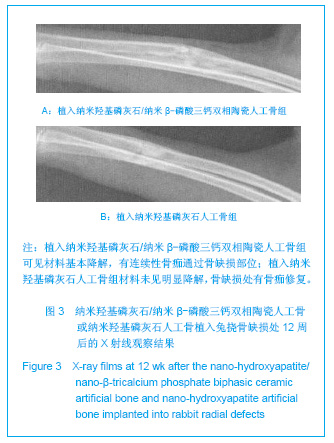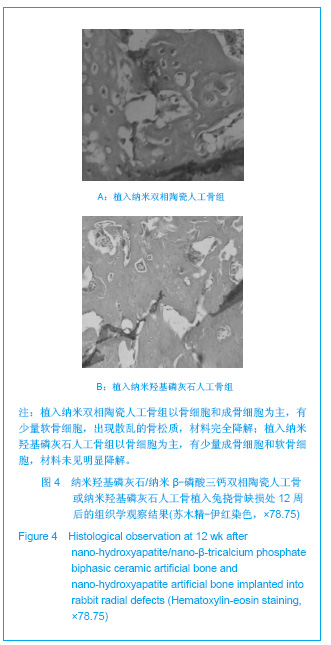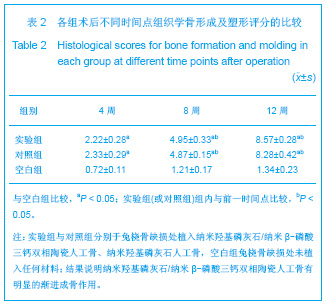| [1] Daculsi G,Laboux O,Malard O,et al.Current state of the art of biphasic calcium phosphate bioceramics. J Mater Sci Mater Med. 2003;14(3):195-200. [2] Cheng SQ,Gou L,Ji JG,et al.Xiandai Jishu Taochi. 2004;25(1): 14-17. 程顺巧,苟立,季金苟,等.双相HA/β-TCP陶瓷的多孔结构对类骨磷灰石形成的影响[J].现代技术陶瓷,2004,25(1):14-17.[3] Hu NM,Chen Z,Liu X,et al.Mechanical properties and in vitro bioactivity of injectable and self-setting calcium sulfate/nano-HA/collagen bone graft substitute.J Mech Behav Biomed Mater.2012;16(12):119-128.[4] He W,Xiao DJ.Guoji Gukexue Zazhi. 2007;28(4):222-223. 何伟,肖建德.复合型纳米羟基磷灰石人工骨的研究进展[J].国际骨科学杂志,2007,28(4):222-223. [5] Daculsi G,Passuti N,Martin S,et al.Macroporous calcium Phosphate ceramic for long bone surgery in humans and dogs:C1inical and histological study. J Biomed Mater Res. 1990;24(3):379-396.[6] LeGeros RZ,Lin S,Rohanizadeh R,et al.Biphasic calcium Phosphate hioceramics: Preparation, Properties and aplications.J Mater Sci Mater Med.2003;14(3):201-209.[7] Xiao DJ.Beijing:Kexue Chubanshe. 2006:414-415. 肖建德.现代骨移植学[M].北京:科学出版社,2006:414-415.[8] Zhu WM,Wang DP,Xiong JY,et al.Zhongguo Weixunhuan. 2006;10(5):344-348. 朱伟民,王大平,熊建义,等. 纳米羟基磷灰石人工骨修复骨缺损的再血管化研究[J].中国微循环,2006,10(5):344-348.[9] Zhu WM,Wang DP,Meng ZB,et al.Zhongguo Linchuang Jiepouxue Zazhi. 2006;24(6): 670-673. 朱伟民,王大平,孟志斌,等. 纳米羟基磷灰石人工骨修复骨缺损的实验研究[J].中国临床解剖学杂志, 2006,24(6): 670-673.[10] Fu JM,Miao B,Jia LH,et al. Zhongguo Zuzhi Gongcheng Yanjiu yu Linchuang Kangfu. 2008;12(1):157-160. 富建明,苗波,贾刘合,等. 纳米羟基磷灰石修复兔颌骨缺损的组织学分析[J].中国组织工程研究与临床康复, 2008,12(1): 157-160.[11] Li SC,Kong XP,Li DC.Kouqiang Yixue Yanjiu. 2008;24(5): 537-539. 李善昌,孔祥盼,李德超.纳米羟基磷灰石修复种植体周围骨缺损的实验研究[J].口腔医学研究,2008,24(5):537-539.[12] Fu JM,Miao B,Jia LH,et al. Zhongguo Zuzhi Gongcheng Yanjiu yu Linchuang Kangfu. 2009;13(12):2387-2390. 富建明,苗波,贾刘合,等. 纳米羟基磷灰石修复兔颌骨缺损的骨密度分析[J].中国组织工程研究与临床康复, 2009,13(12): 2387-2390.[13] Sun QS,Meng XC,Liang N.Heilongjiang Yiyao Kexue. 2003; 26(3):6-7. 孙庆顺,孟祥才,梁楠.纳米羟基磷灰石修复牙槽骨缺损的动物实验研究[J].黑龙江医药科学,2003,26(3):6-7.[14] Shi DW,Zhu ZA,Dai KR,et al.Guowai Yixue:Gukexue Fence. 2003;24(4):241-242,253. 史定伟,朱振安,戴尅戌,等.多孔磷酸三钙修复骨缺损的临床观察[J].国外医学:骨科学分册,2003,24(4):241-242,253.[15] Wang Z,Mao KY,Hou XJ,et al.Jiefangjun Yixue Zazhi. 2008; 33(9):1136-1138. 王征,毛克亚,侯喜君,等. 多孔β-磷酸三钙修复骨缺损的实验研究[J].解放军医学杂志,2008,33(9):1136-1138.[16] Liu Y,Pei GX,Jiang S,et al. Zhongguo Xiufu Chongjian Waike Zazhi.. 2007;21(10):1123-1127. 刘勇,裴国献,江汕,等.新型多孔β磷酸三钙作为骨组织工程支架材料的实验研究[J].中国修复重建外科杂志,2007,21(10): 1123-1127.[17] Liu Y,Pei GX,Jiang S,et al. Zhongguo Zuzhi Gongcheng Yanjiu yu Linchuang Kangfu. 2008;12(23): 4562-4657. 刘勇,裴国献,江汕,等. 新型多孔β-磷酸三钙作为骨组织工程支架材料的评价[J]. 中国组织工程研究与临床康复,2008,12(23): 4562-4657.[18] Ran X,Ran JG,Xing XZ,et al.Sichuan Daxue Xuebao: Gongcheng Kexueban. 2008;40(4):100-103. 冉旭,冉均国,刑现柱,等.微波等离子体烧结制备多孔纳米CHA/β-TCP双相生物陶瓷[J].四川大学学报:工程科学版,2008, 40(4):100-103.[19] He W.Hubei Zhongyi Xueyuan.2009. 何伟.纳米双相陶瓷人工骨的制备和实验研究[D].湖北中医学院博士论文,2009.[20] Zhang LD.Beijing:Huaxue Gongye Chubanshe. 2000:39-41. 张力德. 纳米材料[M].北京:化学工业出版社,2000:39-41.[21] Kühne JH,Bartl R,Frisch B,et al. Bone formation in coralline hydroxyapatite. Effects of pore size studied in rabbits.Acta Orthop Scand.1994;65(3):246-252. |





.jpg)
.jpg)
.jpg)
.jpg)
.jpg)